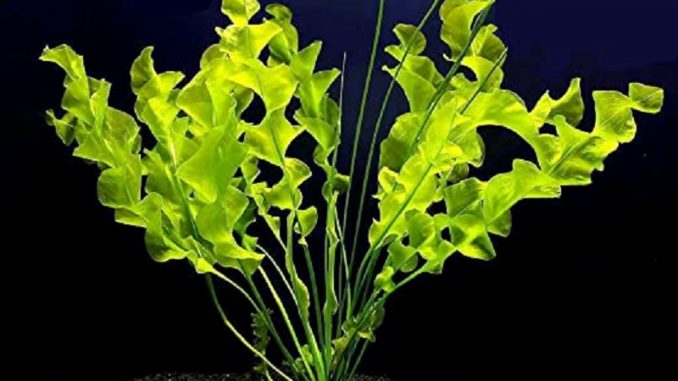
Bulb plants are a special treat for a community aquarium, and Aponogetons are no exception. These planted beauties are prolific, so you want to make sure that you have enough room in your tank for their translucent green leaves that can each grow to about 12 inches in length!
In addition, each bulb can produce more than 40 leaves, so 12 times 40, plus each plant will get about 20 inches wide. Aponogeton are particularly popular with Betta fish; in fact, you will often hear them referred to as Betta bulbs.
If you are up to the task of controlling the Aponogeton growth in your tank, they are a great option. They are easy to take care of and appropriate for beginning hobbyists, and they benefit the community aquarium habitat in myriad ways.
In this article, I’ll discuss everything you need to know about growing and maintaining these twirled plants topped with tiny white flowers, some of the challenges involved, and the benefits to your community. That way, you can make an informed decision as to whether Aponogetons are right for you.
TABLE OF CONTENTS
Aponogeton Facts & Overview
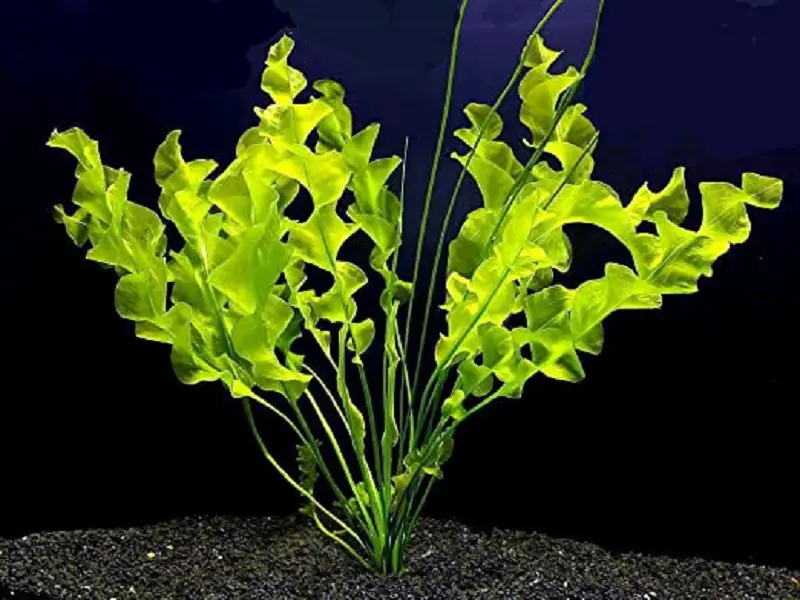
| Category | Rating |
| Care Level: | Easy |
| Temperature: | 72° – 82° F (22° – 28° C) |
| Color Form: | Green with a small white flower |
| Lifespan: | 1 year |
| Size: | 12 x 19.7 inches |
| pH: | 6.5-7.5 |
| Family: | Aponogetonaceae |
| Minimum Tank Size: | 10 gallons |
| Placement: | Middle and background |
| Compatibility: | Great for bettas |
Aponogeton bulbs originate in Madagascar and can be found in Africa, Asia, and regions of Oceania.
When you buy Aponogeton, you are likely to end up with a mix of different species. It would be hard to choose a specific species to buy; you kind of get what you get.
Once it starts sprouting, however, you should be able to tell the origin story of your Aponogeton without too much trouble.
Aponogetons with multiple stems likely hail from Africa; those with a single blooming stalk are likely from Asia. Whichever variety you get, you can be assured that it will be beautiful.
Benefits of Aponogeton
Aponogetons provide a number of benefits to your aquarium and its inhabitants:
- Aesthetics–Aponogetons create a dense and lush feeling of completion to your tank. They recreate the natural habitat of many aquarium fish, including Betta fish. The Betta’s affinity for Aponogeton led to the plant’s nickname, the Betta Bulb.
- Hiding Places–Because the leaves are so thick and dense, aquarium inhabitants will have plenty of places to hide with planted Aponogetons.
- Nutrition–Dead leaves that fall off Aponogetons will serve as food sources for scavengers and detritus eaters.
- Oxygen–Aponogetons convert CO2 to usable oxygen and improve oxygen access for your tank inhabitants.
- Waste Removal–The prodigious growth of Aponogetons results in a need for more nutrition, so they will consume any nutrient in your tank, lowering ammonia and nitrate levels and preventing the growth of algae.
Author’s note: Betta fish really do love Aponogetons for a number of reasons. Not only do they provide hiding places for Betta, but they also provide resting places–Bettas like to sit on the leaves of the Aponogeton and just hang out!
Also, with so many leaves to swim through, Bettas will not get bored and will happily find adventures throughout the day. Bettas and Aponogeton also share most tank conditions; for example, neither can handle a strong current. And since your Betta will most likely be the only fish in the tank, it is especially important to keep them happy and occupied.
However, do not think that Bettas are the only fish that appreciate these lovely plants. Cichlids also enjoy Aponogetons, as do many other species. Careful pairing Aponogeton with Goldfish, who are likely to snack on the live leaves.
Appearance
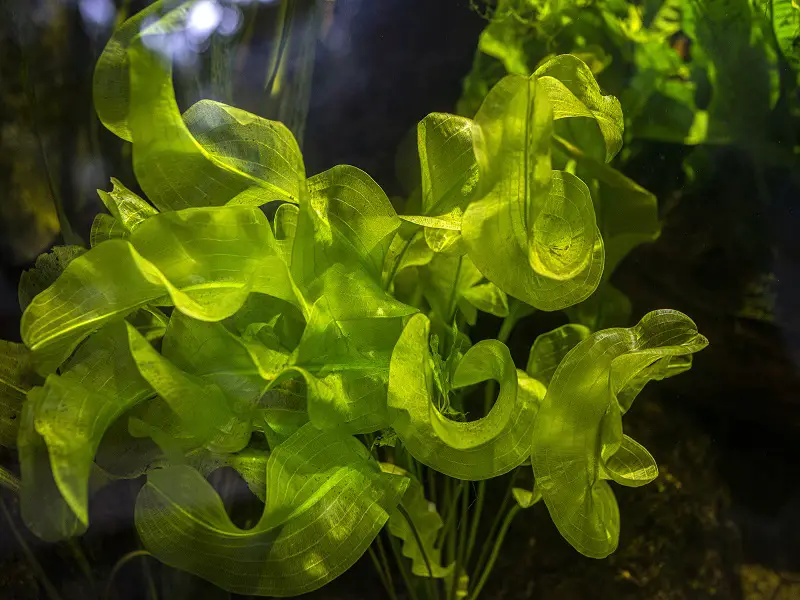
Aponogetons are lovely plants and really add a serene and flowing feeling to your aquascape. With their light green, transparent leaves that twirl into a fluted shape, Aponogetons create a lush background to highlight your aquarium inhabitants.
If the Aponogeton rises above the waterline, it will grow tiny white flowers that shine against the backdrop of the rippled leaves.
Each bulb produces about 40 leaves which are almost a foot long each, and the plants grow horizontally as well as vertically, reaching a width of nearly 20 inches (50 cm).
Habitat and Tank Conditions
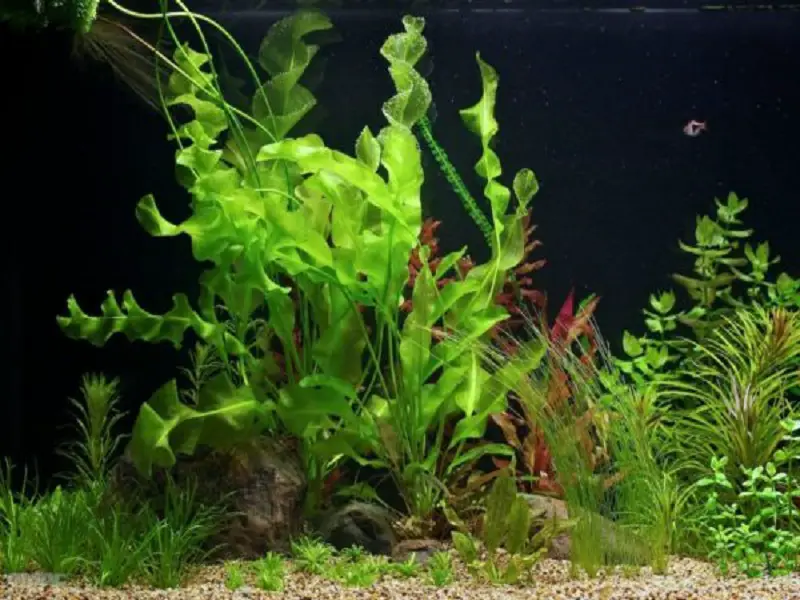
Tank
Choose a tank that is at least 10 gallons for these rapidly growing bulb plants. Aponogetons will grow out and up, even sprouting tiny white flowers outside the water’s surface.
Lighting
One of the things that make Aponogetons easy to care for is that they do not need complex lighting systems that might be difficult for a beginner to navigate. These plants prefer low light, and controlling the light will actually prevent overgrowth. This means that lower light will equal less pruning.
I recommend 10-watt floodlights if you are running a 10-gallon tank. LED floodlights also provide a low-cost way to light your tank.
Substrate
Aquarium Soil is the best substrate option due to the high level of nutrients. Gravel would be the second choice, followed by sand. In the planting and growing section, I will discuss fertilizer and nutrient options if you are using gravel or sand.
Water Conditions
Aponogetons are tropical plants, so they thrive in warmer water that is soft to moderately hard. These warmer temperatures will be a good fit with most tropical fish, assuming the pH conditions are good for the fish.
Ideal Water Parameters for Aponogeton:
- Temperature: 68 to 72°F
- pH: 6.5-7.5
What Size Aquarium Do They Need?
You will need at least a 10-gallon tank for the quickly spreading Aponogeton. The bulb might seem small at first, but once you plant it and it starts growing up and out, you will realize the need for a larger tank. If you are planting multiples in a community aquarium, you might want to go even larger; the Aponogeton can handle it.
You don’t want to overcrowd your tank, as ammonia and nitrate levels can spike, endangering all your aquarium inhabitants.
How Many Plants Can Be Kept Per Gallon?
If you are housing a Betta fish in a 5-gallon nano tank, limit yourself to a single Aponogeton bulb.
Planting and Growing Aponogeton
Easy enough for beginning hobbyists, Aponogetons grow fast and wide. Once you get the planting down, you won’t have to do much.
Planting
- Select a background or middle ground place to plant your bulb(s), with the back of the tank being the first choice.
- If you are planting multiples, bury them 2 or 3 inches apart.
- Although you’re going to bury the bulbs in the substrate, don’t totally cover them; only go deep enough to hold them in place.
- Plant the thicker end of the bulb in the substrate if it has not already started to sprout.
- If the bulb has started to sprout, make sure the roots get buried and not the sprout.
Substrate and Nutrients
Aquarium soil is best since it is nutrient heavy. However, if you are planting Aponogeton in an already established tank, you will already have a substrate. In this case, you can supplement with fertilizer capsules or tablets near the plant’s roots.
If you don’t use aquarium soil, gravel is more optimal than sand.
Pro tip: Don’t read my recommendation for aquarium soil as marching orders to swap out your whole substrate. Doing so is contraindicated as you will put your fish at risk by changing the system’s biological filtration processes.
If you are growing Aponogeton in a nano tank, you may need to encourage growth with liquid carbon.
Care
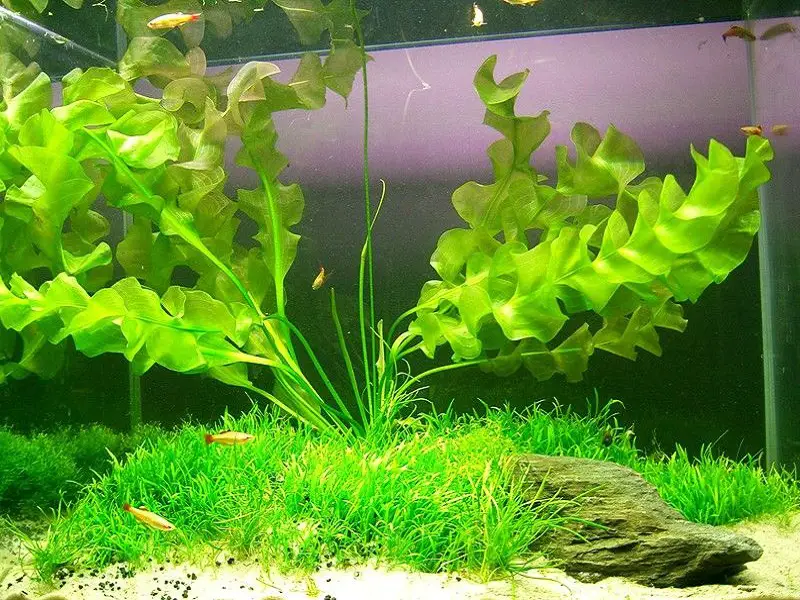
Make sure the light is not too bright for Aponogetons; they prefer low-intensity light.
If you are using a gravel substrate, you may want to add fertilizer, but keep in mind that Aponogetons grow really quickly, so there is a good chance you won’t need it even if you are not using aquarium soil.
Prune your Aponogetons as needed if they start to take over your tank. To minimize rotting, trim the stems as close to the bulb as you can.
Bulb plants growing outdoors need to be rested. Resting refers to the time during the dry season when the leaves are exposed to air and die; this is a part of nature’s rejuvenation cycle and actually prepares the bulbs for the rainy season by allowing them to build up nutrients.
In a home aquarium, of course, your bulbs will remain submerged, the bulbs will not dry out, and the leaves will not die. That order of events seems like a positive, but it will mean that you will need to supplement nutrients with fertilizer, CO2 injections, or carbon dosing.
If you do choose to rest your Aponogeton bulbs, remove them from the tank, also removing all roots and leaves. Then put the naked bulb in a bag and surround it with damp sand. After two months in a cool, dry space with little to no light, you can replant the bulbs.
Is Aponogeton Suitable for Your Aquarium?
Adding a bulb plant to your aquarium not only adds to the aesthetic but also helps with oxygen levels in your tank; gives your fish and invertebrates places to hide; helps remove waste, and improves water quality.
If you’re trying to decide on the best bulb plant for your finned friends, Aponogeton is a great choice. It’s hearty, easy to grow and so suitable for beginning to advanced hobbyists, and has a unique and appealing appearance. And live plants just look so much nicer than plastic.
Do you like the twirly look of Aponogetons? Let us know why in the comments below.

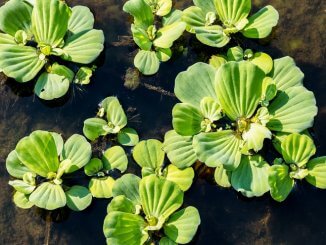
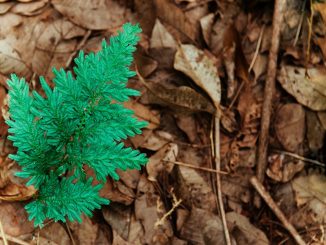
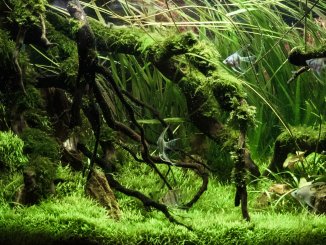
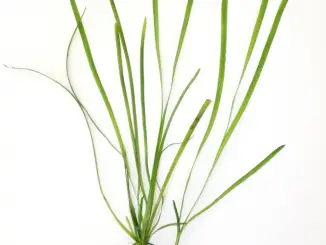
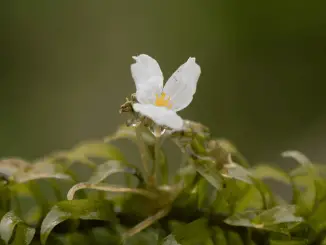
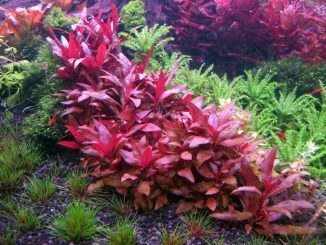
How long should an aponogeton bulb take to sprout once “planted” in the substrate? When do I know if it’s a dud?
mine started sprouting after about 2 weeks.
Thank you for this informative article! But please forgive me, I know a little bit about resetting flower bulbs, and that some bulbs need to be fully buried, and some need to have their top above the dirt. Should the aponogeton be completely buried, or leave the top above the sand? Also, what kind of bag is recommended (plastic or paper?) and should it be loosely covered, or be zipped up like in a ziploc bag? If we see the bulb has put up shoots before 2 months, should we go ahead and plant it in the aquarium, or do we wait for the shoots to get a certain height?